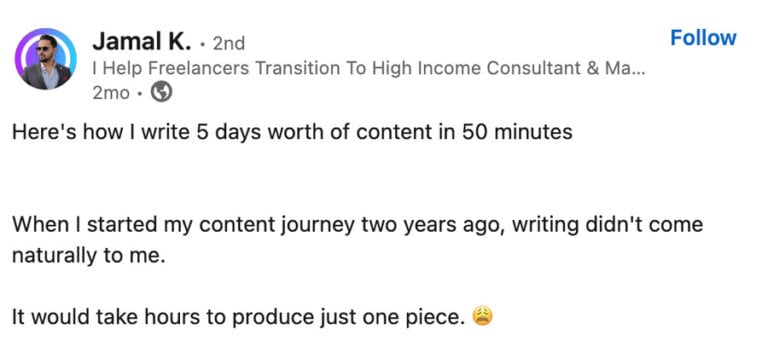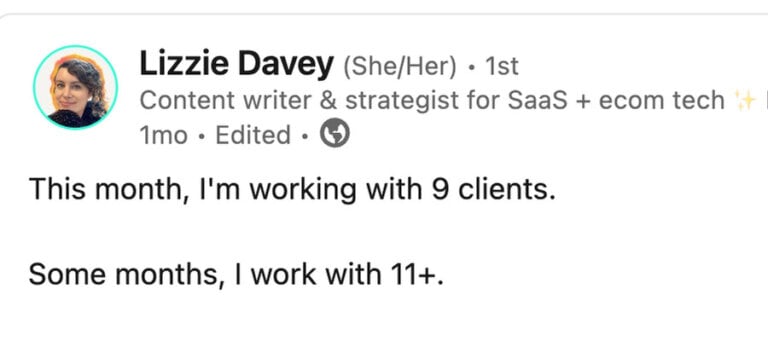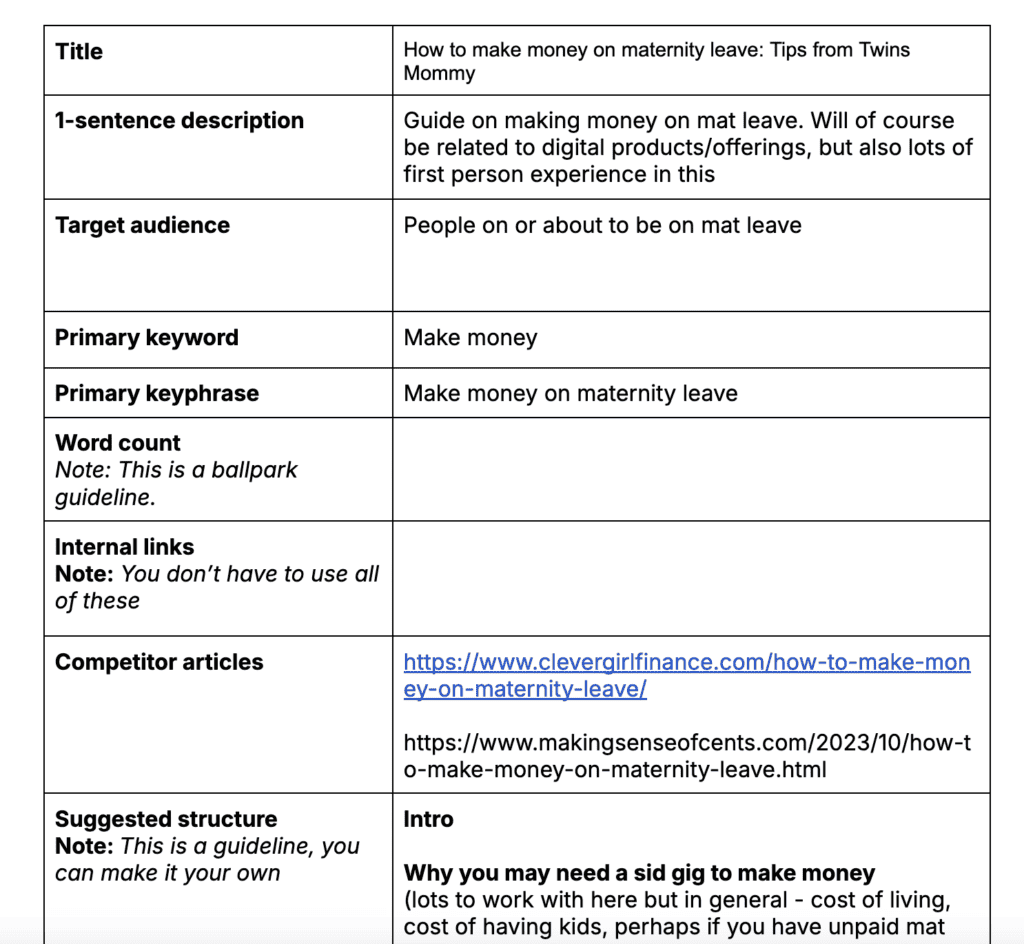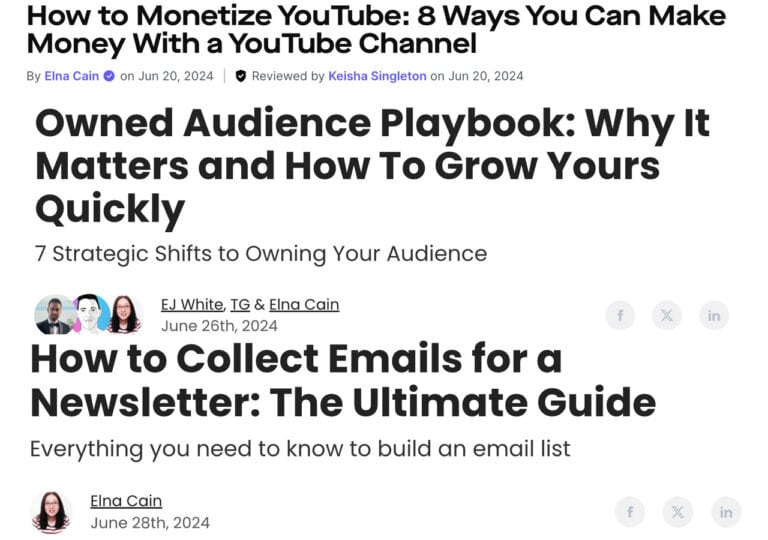When a freelance writing client gives me a 3,000-word article, it usually takes me ten days to write it.
I mean, it doesn’t take ten actual days to write the article, but I would space out my time to do some research, do a little writing ( like the introduction), wait for subject matter experts, or get distracted with life – twins, dinner, chores, sports, etc. And by the time I get time to write the article, ten days or so have passed.
But this year, I decided to change that.

This year, I wanted to work on my writing process, streamline processes, and reduce those ten days to less than three days.
This means the post is fully written, edited, and submitted within 3-4 days.
Is this possible with multiple businesses, YouTube channels, and clients?
I Was Getting a Little Jelly
I see a lot of freelance writing posts on LinkedIn, and now and then, I see posts of young writers sharing how fast they are writing their content for clients.

I would see this over and over again.
Other times, it’s how many clients freelance writers are working with.

Why am I struggling to manage three clients at a time?
Why does it take me soo long to write 3,000 words for a freelance writing client?
What gives?
These are the thoughts I go through every single time I write for clients.
I needed this to change.
Requirements to Write 3,000 Words
I decided that to cut down my writing process from ten days down to three days I had to ONLY take on projects I know I could write.
This all boiled down to knowing the topic.
To write fast, I had to be knowledgeable about the topic and feel comfortable writing about it.
I didn’t realize it, but all the posts I write for this blog you are reading right now are thousands of words, and some of them take me just a few hours to write.
Why? Because I know this subject…and boy, do I know this subject.
I’ve been writing about freelance writing for a decade, so I better know the ins and outs of writing online.
So, if you recently landed a client and want to write fast, know the subject you’re writing about.
Only some of the clients I have give me topics I know about.
My latest project was about event marketing emails.
The first time I read that term, I got a brain fart and was like, “What the heck are those?”
In the 10+ years of reading online content, I never came across that term.
So, I hyperventilated and ignored the email for a few days.
I needed that time to talk about the topic and read about it.
So, for “new” topics, it takes me longer than three days to write.
While I wrote the post in four days, the prep for it was about four days, too, for a total of 8 days for that post.
For my other client, they gave me a post about Pinterest.
I could write about Pinterest with my eyes closed. I ended up writing 3,000 words in two days.
Okay –
So is that ALL you need to write fast?
Know the topic?
Well no.
I’ve written content I know about for clients for many years, but the post still took me ten or more days to write.
So, what really changed?
Let’s look at the process I use to ensure that practically every client article I write takes me around three days.
1. A Content Brief

A content brief is a document given by the client detailing what you will write for them.
It will usually have:
- The title
- Who the audience is
- Meta description
- Keyword/s
- Competitor links
- Outline of post (i.e. subheadings)
Businesses SHOULD be giving their writers this document, but I know there are many companies that don’t.
Some don’t have a content team or editor while others really don’t have an editorial calendar.
I’ve been fortunate enough to have my current clients give me a content brief.
Now, for any new prospects that want to hire me, one of the first questions I ask is if they give content briefs to their writers.
Why is this important?
Because it makes the writing soo much easier.
I don’t have to spend hours pitching blog topics and I don’t have to sit there and create the outline trying to guess if they want this post highly SEO’d or more brandable.
With a content brief there is no guesswork and that means you’ll have happy clients!
2. A Dump Doc
For every content piece I write for clients, I have a dump doc.
This is a document where I ‘dump’ stats, images, links or parts of my first draft.
When I started out I didn’t have this dump doc. It’s only recently, in the last few years, that I heard about this document on LinkedIn from other writers.
So, I decided to adopted this in my writing process.
I find that it saves me a ton of time with research. I can decide a time to research and use this dump doc to gather all the information I need.
3. A Swipe File or Two
Another important document I use is my swipe file.
A swipe file is a document where you can collect statistics and facts about your niche or industry.
I’ll include:
- Current trends
- Specific topical statistics
- Links to case studies
I have two swipe files – one for SaaS stats and one for general content stats – and I’ll take a quick look to see if I can use any of the stats in my swipe file.
The Content Process for Writing 3,000 Words Quickly
So with the requirements out of the way, here is my process for writing 3,000 words quickly.
1. I Use AI Tools to Speed Up the Writing
Part of the reason I took days to write a client blog post was because of writer’s block.
I couldn’t finish certain sentences and couldn’t find the words that I wanted to use.
So, I would stop writing and sleep on it and do more research until the words came to me.
As you can see, you don’t want to have writer’s block because it just slows everything down for you.
That’s why I’m glad that AI writing tools like ChatGPT can help with writer’s block and so much more.

In one of my YouTube Lives I show you how I use ChatGPT for client pieces.
What ChatGPT gives me are ideas to help me write faster.
2. I Give Myself Only 20 Minutes
When a client gives me an article brief I give myself only 20 minutes to read it and type out the outline on a Google doc.
Unless it’s a topic I don’t know, I can usually get a good idea of how to write the article based on the content brief.
And for me, this usually takes around 20 minutes.
3. I’m Familiar With the Topics
Having familiar topics is vital to writing fast.
The ideas come naturally and writing sentences become more fluid. You often trip yourself up because your ideas are coming so fast but you can’t keep up with the typing.
This is what I strive for with my client pieces.
I get excited when I see a topic I know about, like writing about newsletters, or YouTube, or about my maternity leave.
But this does take time – even years – to fully understand your writing niche.
As I mentioned, I mostly wrote topics I’m familiar with for most of the years I’ve been a freelance writer.
It was only in the first year, or first few months, that I wrote on topics I had no idea about like VFX, dentistry, automotive, HR practices, and more.
But, I then picked up a client that wanted me to write about content marketing, and since I was learning about this topic for my writer website, I accepted the gig and wrote about blogging topics.
Over time, this knowledge spread to email marketing and social media marketing. I also dabbled in these topics by having a few newsletters, being on social media, and eventually creating my own products.
All of that helped me learn my niche inside and out so that I can write about it easily.
4. I Set Longer Writing Times
An active step I took this year was to set longer writing times.
I tend to write for only a half hour before I become ‘uncomfortable’ and have to stand up and take a break.
I would go downstairs, get a drink, check my phone, do laundry, etc..everything but write.
But, this year is different.
This year I told myself that I needed to write non-stop for an hour. It first started with 30 minutes, then 45 minutes and then an hour.
I eventually want it to be three hours uninterrupted time but this will work better once my twins are in school (it’s summer as I’m writing this).
This one step really helped me finish my articles much faster.
So, instead of breaking up three hours into twenty minutes here, thirty minutes there, wait the next day and do another thirty minutes, now, I do that all in one sitting.
Doing this was definitely a game-changer.
5. I Write Top-Down
My writing process is top-down.
What this means is I have to start at the introduction to write my article.
I can’t start in the middle or at the end.
I know there are other freelance writers that can do this, but I can’t.
I need structure in order to write and that means writing the introduction and knowing the angle and how I will approach my article.
The Result
As you can see, these posts were published so quickly after I wrote them. I like seeing my published pieces from all my clients at the same time.
I am proud of that!

Let me know in the comments if you found this helpful or if you’re struggling to write faster!




5 Comments